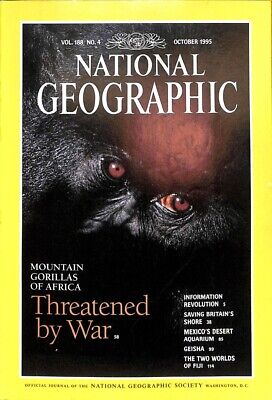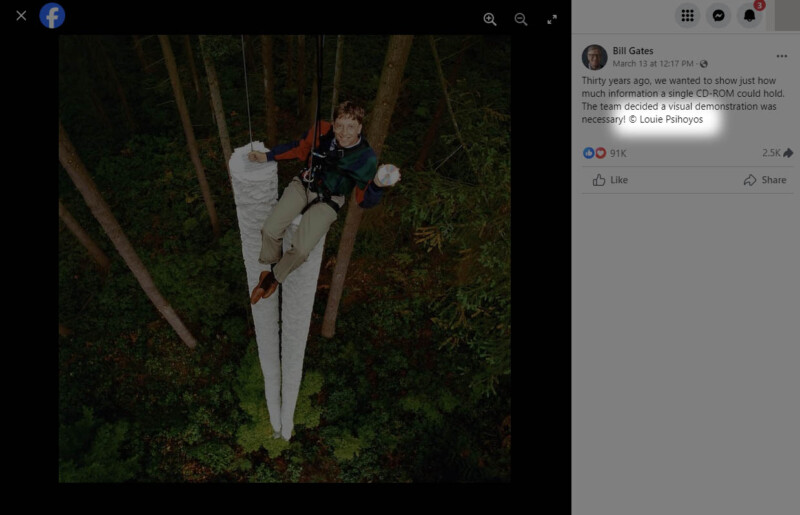![]()
Bill Gates recently posted a photograph on Facebook that one could easily deduce from his sparse captioning was made by him and his team – not the mildly (and formerly) irritated author writing now.
I created the image for a National Geographic for a story about the Information Revolution, published in October of 1995.

It took about a month to set up. Bill Douthitt was the photo editor of that story and looking back, the magazine gave us a pretty long leash to execute some pretty crazy ideas. I wanted to illustrate the information storage capability of a CD-ROM, which at the time could hold the equivalent of 330,000 sheets of 8 1/2” x 11” paper with single space typing. I thought of laying all the paper out in a grid in a large warehouse but the only building big enough in the Seattle area was a Boeing hanger. Unfortunately, it was being used to make 747s.
My friend and assistant, John Knoebber, was once a clown and then a bartender and later a building contractor, but his unique CV led to a solution that initially sounded like a circus trick dreamed up by an engineer who had been drinking too much. John recommended we drill holes through all the paper, put a steel cable with a feral bolt and a steel plate welded to the bottom, and stack the paper up like bar napkins. We wanted somebody well known in tech to be on the stack so I reached out to Microsoft to see if Bill was available for some high-wire work.
Using a crane to set someone on top of the stacks of paper would be relatively simple, but right before our shoot, a crane collapsed at the Kingdome, tragically killing two workers. When OSHA and WISHA, the federal and state safety organizations, heard we wanted to dangle the second richest titan in the world from a crane, they weren’t in a Cirque du Soleil kind of mood. They required that Gates wear a yellow full-body harness and a hard hat.
I protested that we wouldn’t even recognize Mr. Gates with all that distracting and very unnecessary safety gear. I told the OSHA agent, “Mountain climbers don’t have to wear that much safety gear.”
“If you lift him with cranes, those are the rules,” was the reply.
So we hired our friend Andy Taylor who was an arborist/mountain climber, to rig a Tyrolean traverse between four trees behind the Microsoft headquarters. A 100-ton crane lifted the tower of paper, I drove Gates to the top of the stacks with a bucket lift, he gingerly clipped onto Andy’s belay, and he climbed out of the bucket lift where he was no longer in the jurisdiction of OSHA’s rules. Gates held on to the cable and Andy lowered him down onto the stacks of paper which were about 55 feet high.
I’m grateful to Bill — he started the Giving Pledge, an organization of fellow titans who he convinced to give away half their wealth in their lifetimes, and my organization, OPS, has been a recipient of some of that initiative. Bill also owned a photo agency called Corbis which represented my work including the image below which they licensed to others several hundred times. At one time Corbis offered to buy out my entire photographic library but I turned them down. So it’s hard to imagine that Bill didn’t realize photographers actually get paid for the experience of publishing their work or that at the very least require a proper credit.
I shared this in a Facebook post last Friday and wrote, “So Bill, wherever you are, you owe me $275.00 and please add ©️Psihoyos Photography. P.S. that’s the ‘team’ discount..”
I never expected to really hear back from Bill, but within a few hours of my post, I was shocked to see that a payment from Gates Ventures showed up in my inbox, about twice the fee I proposed. And when I checked his post again I saw that this time it also included my credit along with a copyright symbol.

The whole project seems quite surreal, from creating the image to getting a resolution for its use by him so quickly.
About the author: Louie Psihoyos is a former National Geographic photographer is the executive director of a non-profit, the Oceanic Preservation Society which uses photography and film to scale social change. His first film, The Cove, won an Oscar and became the first documentary to sweep all the film guilds. He also directed Racing Extinction, The Game Changers, Mission:Joy and You are What you Eat:Twin Experiment. He has directed projection events on the United Nations, The Empire State Building and the Vatican which have achieved over 5 billion media views.
